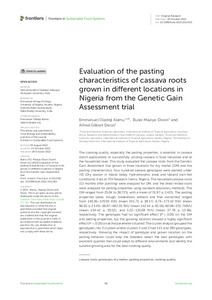| dc.contributor.author | Alamu, E.O. |
| dc.contributor.author | Maziya-Dixon, B. |
| dc.contributor.author | Dixon, A. |
| dc.date.accessioned | 2022-12-05T12:24:48Z |
| dc.date.available | 2022-12-05T12:24:48Z |
| dc.date.issued | 2022 |
| dc.identifier.citation | Alamu, E.O., Maziya-Dixon, B. & Dixon, A. (2022). Evaluation of the pasting characteristics of cassava roots grown in different locations in Nigeria from the Genetic Gain Assessment trial. Frontiers in Sustainable Food Systems, 6: 1012410, 1-11. |
| dc.identifier.uri | https://hdl.handle.net/20.500.12478/7961 |
| dc.description.abstract | The cooking quality, especially the pasting properties, is essential in cassava starch applications or successfully utilizing cassava in food industries and at the household level. This study evaluated the cassava roots from the Genetic Gain Assessment trial grown in three locations for dry matter (DM) and the pasting characteristics. Four hundred cassava genotypes were planted under IVS (Dry season in Inland Valley Hydromorphic area) and Upland (rain-fed conditions) trials at IITA Research Farms, Nigeria. The harvested cassava roots (12 months after planting) were analyzed for DM, and the dried-milled roots were analyzed for pasting properties using standard laboratory methods. The DM ranged from 25.04 to 38.72%, with a mean of 31.97 ± 2.41%. The pasting properties (peak, trough, breakdown, setback and final viscosities) ranged from 140.36–570.93 RVU (mean 241.71 ± 38.17), 6.74–173.32 RVU (mean 96.65 ± 23.45), 66.97–482.35 RVU (mean 142.44 ± 30.16), 60.06–231.74RVU (mean 134.42 ± 30.52), and 5.22–135.69 RVU (mean 37.78 ± 12.96), respectively. The genotypes had no significant effect (P > 0.05) on the DM and pasting properties, but the growing location showed a highly significant effect (P < 0.05) on all the parameters studied. The cluster analysis grouped the genotypes into 2 clusters where clusters 1 and 2 had 115 and 285 genotypes, respectively. Knowing the impact of genotype and grown location on the pasting behavior could help the breeders select the best genotypes with excellent qualities that could adapt to different environments and identify the suitable growing area for the best cooking quality. |
| dc.description.sponsorship | CGIAR Research Program on Roots, Tubers and Bananas |
| dc.description.sponsorship | Bill & Melinda Gates Foundation |
| dc.format.extent | 1-11 |
| dc.language.iso | en |
| dc.subject | Cassava |
| dc.subject | Roots |
| dc.subject | Genotypes |
| dc.subject | Dry Matter |
| dc.subject | Cooking |
| dc.subject | Nigeria |
| dc.title | Evaluation of the pasting characteristics of cassava roots grown in different locations in Nigeria from the Genetic Gain Assessment trial |
| dc.type | Journal Article |
| cg.contributor.crp | Agriculture for Nutrition and Health |
| cg.contributor.crp | Maize |
| cg.contributor.crp | Roots, Tubers and Bananas |
| cg.contributor.affiliation | International Institute of Tropical Agriculture |
| cg.coverage.region | Africa |
| cg.coverage.region | West Africa |
| cg.coverage.country | Nigeria |
| cg.coverage.hub | Eastern Africa Hub |
| cg.coverage.hub | Headquarters and Western Africa Hub |
| cg.researchtheme | Nutrition and Human Health |
| cg.identifier.bibtexciteid | ALAMU:2022e |
| cg.isijournal | ISI Journal |
| cg.authorship.types | CGIAR Single Centre |
| cg.iitasubject | Agronomy |
| cg.iitasubject | Cassava |
| cg.iitasubject | Food Security |
| cg.iitasubject | Plant Production |
| cg.iitasubject | Value Chains |
| cg.journal | Frontiers in Sustainable Food Systems |
| cg.notes | Open Access Article; Published online: 28 Oct 2022 |
| cg.accessibilitystatus | Open Access |
| cg.reviewstatus | Peer Review |
| cg.usagerightslicense | Creative Commons Attribution 4.0 (CC BY 0.0) |
| cg.targetaudience | Scientists |
| cg.identifier.doi | https://dx.doi.org/10.3389/fsufs.2022.1012410 |
| cg.iitaauthor.identifier | Alamu Emmanuel Oladeji: 0000-0001-6263-1359 |
| cg.iitaauthor.identifier | Busie Maziya-Dixon: 0000-0003-2014-2201 |
| cg.futureupdate.required | No |
| cg.identifier.volume | 6 |

